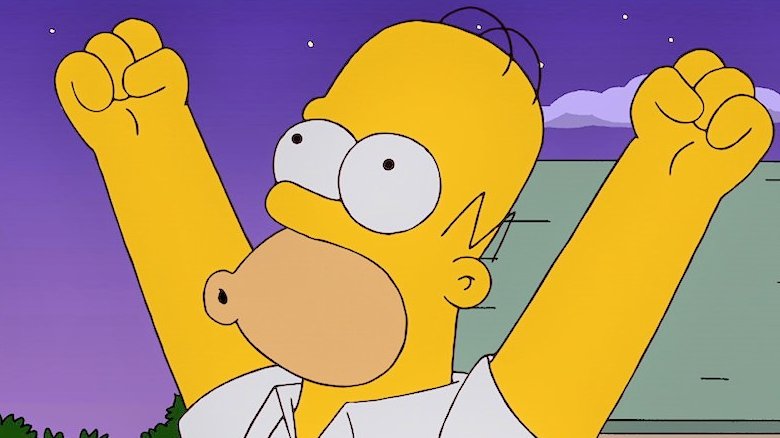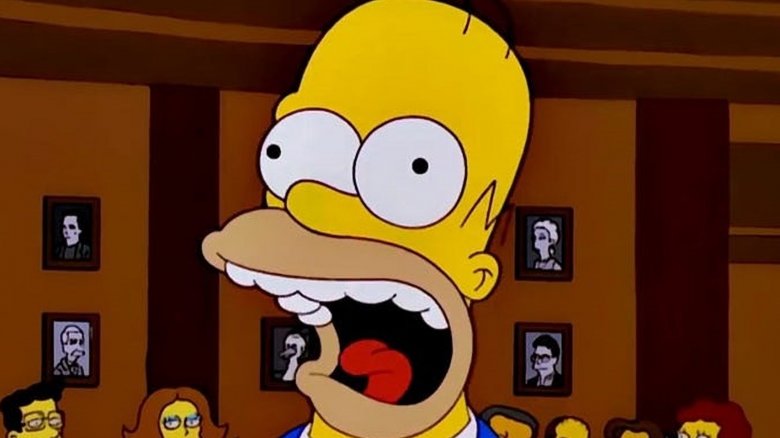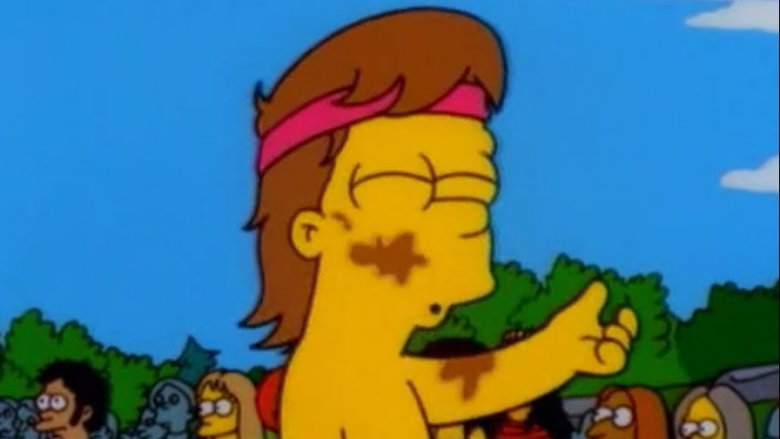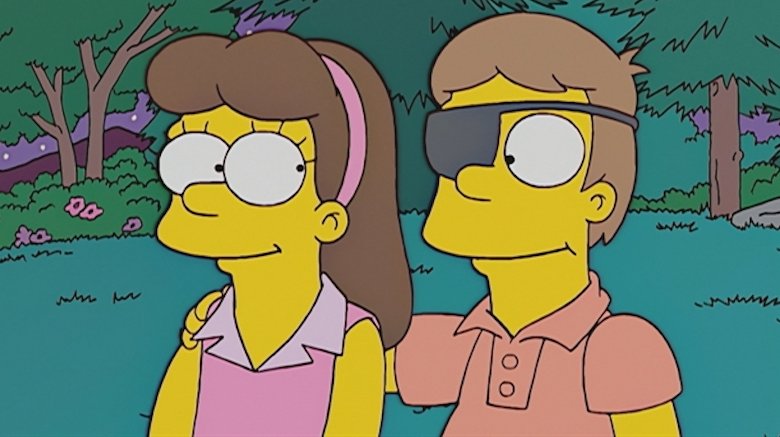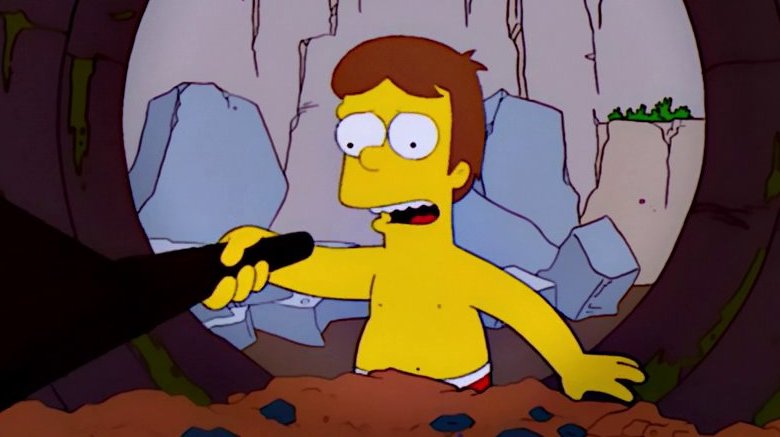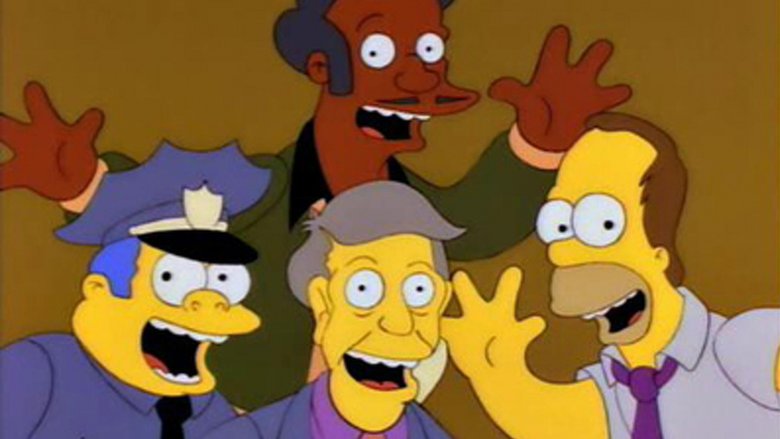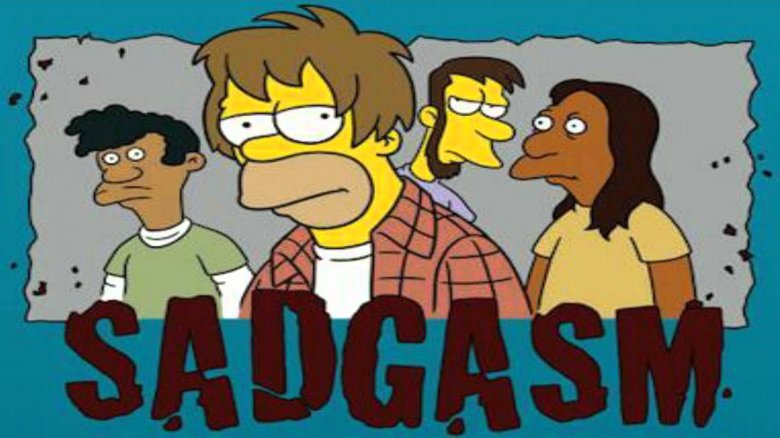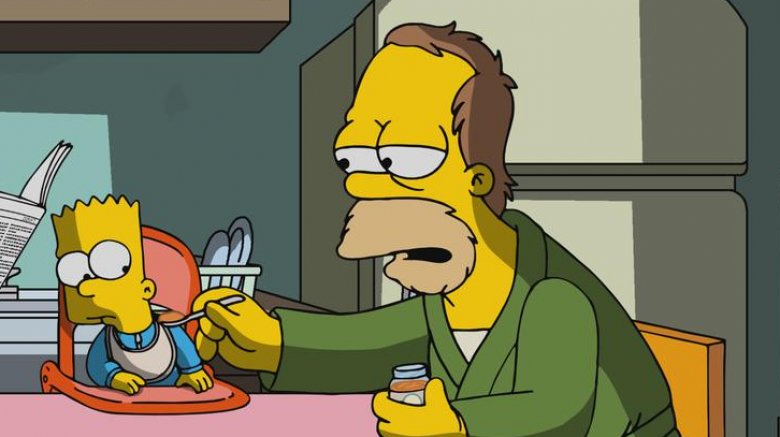Homer Simpson's Backstory Explained
Homer Simpson is selfish, gluttonous, ignorant, rash, and proud of all those things. He's a man of simple pleasures — beer, doughnuts, "snuggling" with Marge, sitting on the couch watching TV — who will do whatever it takes to get those pleasures. And yet, Homer contains multitudes. He's deeply in love and devoted to his wife, and he really wants to be a good parent to Bart and Lisa, although his son's bad behavior aggravates him to the point of strangulation, and he has a hard time relating to his sensitive, hyper-intelligent, artistic daughter. (As for Baby Maggie, "he's got nothing against" her.)
Homer Simpson is a complex man, and The Simpsons has provided more than 600 episodes for him to develop into one of the most fascinating and hilarious characters in television. But how did he get to be the man he is, the author of Homer, I Hardly Knew Me? Before he became a working stiff at the nuclear power plant, started driving a pink car, and began living in a suburban tract house with three kids, he lived a lot of life — several lifetimes, even. Here's Homer Simpson's backstory explained.
How old is Homer Simpson anyway?
When The Simpsons graduated from a sketch on The Tracey Ullman Show to a full-length standalone series, Homer was 34 years old, according to the January 1991 episode "The Way We Was." Plus, the episode "Duffless" says Homer's birthday is May 12. So if we do a little bit of math, that means Homer was born in 1956.
He then aged at a normal chronological rate, at least for a while, because in the late 1992 episode "Lisa the Beauty Queen," he's 36. After that, Homer's aging process slows down considerably. Four years after "Lisa the Beauty Queen," in the 1996 episode "The Homer They Fall," he's still in his late 30s. Two years after that (in 1998's "The Wizard of Evergreen Terrace"), he has a midlife crisis when he realizes that at age 38.1, he's halfway to the male lifespan of 76.2. Homer finally hits the big 4-0 in the episode "Springfield Up," which aired nearly nine years after the episode where he freaked out about being 38.1.
Because Homer's age stays in the same roughly five-year period over the course of 30-plus seasons of television, it gives writers the ability to play fast and loose with his actual age, as well as the opportunity to revise his backstory every few years. In various flashback episodes, Homer has been a boy, teenager, or young man in every decade from the '60s onward.
He's a child of the '60s
For better or for worse, Homer Simpson is a fairly conservative, mid-century, Midwestern guy. In other words, he's a real man's man. He's the member of a fraternal organization (the Stonecutters), he bowls in a league, and as he tells Marge in the episode "Homer Sexual," in which he struggles with his homophobia, he likes his beer cold and his wings hot.
And yet there's a rebellious, countercultural streak in Homer Simpson that comes out on occasion, reflecting his upbringing as the child of a hippie. In a flashback during the 1995 episode "Mona Simpson," Homer's mother, Mona, leaves behind her unfulfilling life as a wife and mother to be a '60s political radical, having had an epiphany after seeing the long, sexy hair of Joe Namath during Super Bowl III in 1969. She spends the next 27 years on the lam, evading prosecution for her role in an attack on a germ warfare lab owned by Mr. Burns. But she apparently had the time in 1969 to help Homer form some influential, if subconscious, memories. As it turns out, she took him to Woodstock, where Homer, who looks to be about five or six, got into the spirit and danced naked in the mud.
How he met their mother (the first time)
The 2004 episode "The Way We Weren't" adds another chapter of Homer's childhood to the vast Simpsons mythos, as well as another layer to his complex, meant-to-be relationship with Marge. The flashback-heavy episode finds Homer "back in the '60s, or '50s, or maybe it was the early '70s." (That's clearly a self-referential joke from Simpsons writers that proves they're well aware of the show's complex and sometimes contradictory timeline.) And the flashbacks start when Homer lets slip that his first kiss wasn't with Marge back in high school, so he tells the family the real story of how he came to smooch for the very first time.
During Homer's tale, he attends a summer camp for underprivileged kids called Camp See-A-Tree. In addition to being the place where he stabs himself in the eye with a switchblade, it's also where he meets his lifelong best friends for the first time: fellow campers Lenny, Carl, and Moe (although Moe is a counselor who's been abandoned there by his parents). On top of all that, Homer and a camper at the girls comportment camp across the lake — Camp Land-A-Man — hit it off, and it's she who gives Homer his first kiss. Due to the fog of memory — or maybe Homer's below-average intelligence — neither he nor Marge realize until this very moment that Homer's camp girlfriend was ... Marge. But to be fair, at the time she had brown hair, as opposed to blue.
Homer had a rough childhood
Homer Simpson certainly bears the emotional scars and self-destructive behavior of someone who's experienced childhood stress and trauma. For example, his mother left when he was grade-school age (and his supremely harsh and unsympathetic father told him that she'd died). When he was six, he shoved 16 crayons up his nose, impairing his brain function for decades. Even worse, he started drinking heavily while still in high school.
And then there's that time when, at age 12, he went for a swim with his friends down at the quarry and stumbled on a dead body, a memory so horrifying that he repressed it for years. It comes rushing back in the 2001 episode "The Blunder Years" after falling under the spell of a restaurant hypnotist, prompting him to horrifically scream for an entire night and day. A present-day investigation reveals it to be the body of Waylon Smithers Sr., who heroically died preventing a meltdown of the newly-opened Springfield Nuclear Power Plant, where Homer would wind up working down the line.
The Simpsons in the '70s
Homer was a high school senior in the groovy year of 1974, according to the 1991 episode "The Way We Was," which details the story of how he met Marge (the camp thing hadn't occurred to him yet). Plus, the episode gives insight into the life of teenaged Homer. He was best friends with future barfly Barney back in the day, although their intoxicant of choice at the time was marijuana. Their principal busts "Springfield's answer to Cheech and Chong" for smoking, landing them in detention, where they're joined by Marge Bouvier, nicked for burning her bra at a feminist protest.
For Homer, it's love at first sight, and he maneuvers to get closer to her, even providing her with references to prove he's a good guy. (According to the track coach, Homer was a JV shot-putter, and the shop teacher says Homer took the class for four years, earning a C every time). Homer finally gets some alone time with Marge when he pretends to be failing French, so that she can tutor him. Sparks fly, Homer asks Marge to the prom, but after he admits he lied about needing French help, she casts him off. Homer still thinks they're on for prom, but to prevent her from officially cancelling, he avoids her — and school — for three weeks. And as a result, he'll have to attend summer school to graduate on time. D'oh!
Homer Simpson in his 20s
For Homer, starting fatherhood in his 20s was a surprise. Per the 1991 episode "I Married Marge," which is set in 1980, Homer is working at a miniature golf course. It's inside a castle on those very grounds where Homer and Marge conceive Bart, and soon thereafter, they marry in a sleazy wedding chapel. Looking to move up in the world to support his new family, Homer unsuccessfully applies for a series of jobs, including a position at the nuclear power plant, before winding up at the local Gulp N' Blow taco stand. Finally, on the day Marge goes into labor, Homer wins himself a job with Mr. Burns.
It's not all serious life benchmarks for young adult Homer Simpson, however. In 1977, he and Barney go on The Gong Show, and their two-men-in-one-pair-of-overalls-playing-a-giant-harmonica act gets "more gongs than the breakdancing robot that caught on fire." He has a bit more success in the musical field later on, when in 1985 he forms the Be Sharps, a barbershop quartet that becomes a Grammy-winning pop sensation with their hit "Baby on Board." By the late '80s, Homer is still working at the power plant to support his family and pay down some debts, at which point he spectacularly quits that job to take his dream gig at a bowling alley. In celebrating this personal triumph, Homer and Marge conceive Maggie ... which means Homer has to beg to get back his higher-paying job at the power plant.
Springfield must be near Seattle
Because The Simpsons has aired for so long — over 30 season so far — events that happened in the characters' lives decades earlier no longer make mathematical or chronological sense. For while the conceit has long been that Homer and Marge first fell in love in 1974, the 2008 episode "That '90s Show" overlooks that fact and puts the couple's origin in the early 1990s.
At this point in time, Homer and Marge are dating, not yet married with kids, and they live in an apartment in hip Springfield Place. When Marge gets admitted to Springfield University, Homer quits the Boyz II Men-esque duo he's in with Lenny, Carl, and Lou in order to earn tuition money by working at his father's laser tag arena. Marge, meanwhile, wades into a relationship with a cool professor, which sends Homer into an emotional spiral. He gets the band back together, but now as Sadgasm, a grunge band with angry, disaffected tunes. Marge soon realizes she'd rather be with Homer, who at that point has left the band and secluded himself in his mansion, where she finds him strung out and surrounded by needles. The lovers reunite, and it turns out those needles weren't for heroin but insulin, as Homer Simpson was evidently diagnosed with diabetes in his 20s.
Millennial Homer Simpson
After "That '90s Show," another decade of The Simpsons came and went, which meant it was time for another revision of The Simpsons backstory. In the 2018 episode "3 Scenes Plus a Tag from a Marriage," viewers discover that Homer and Marge used to live in a fifth-floor walk-up apartment in a funky, Brooklyn-esque neighborhood of Springfield about ten years earlier (so then, 2008), where they happily led the life of "DINKs" — dual income, no kids. That meant partying, going to wine bars, and attending movies at a revival house.
But in this timeline, Marge gets pregnant with Bart, and their party days are soon over. Homer then loses his job at a startup (the CEO doesn't want his employees to be distracted by having families), while Marge loses hers as a reporter at the Springfield Shopper, after toddler troublemaker Bart destroys an art exhibit she's covering, losing the paper its lucrative art world advertising. Bart's such a menace that he's even kicked out of daycare. At the suggestion of a parenting video from Reverend Lovejoy that attests "only children are lonely children, and lonely children are evil children," Homer happily agrees to try for a second kid. And obviously, that would be Lisa.
